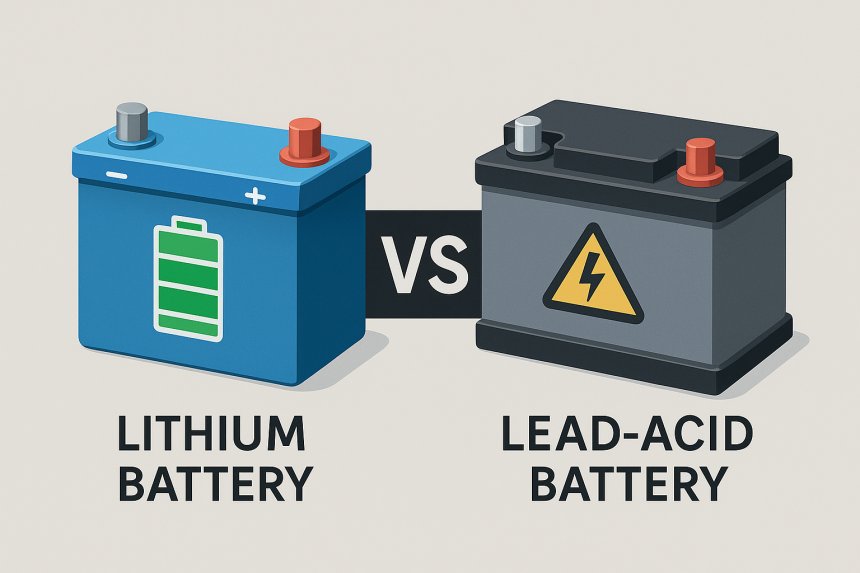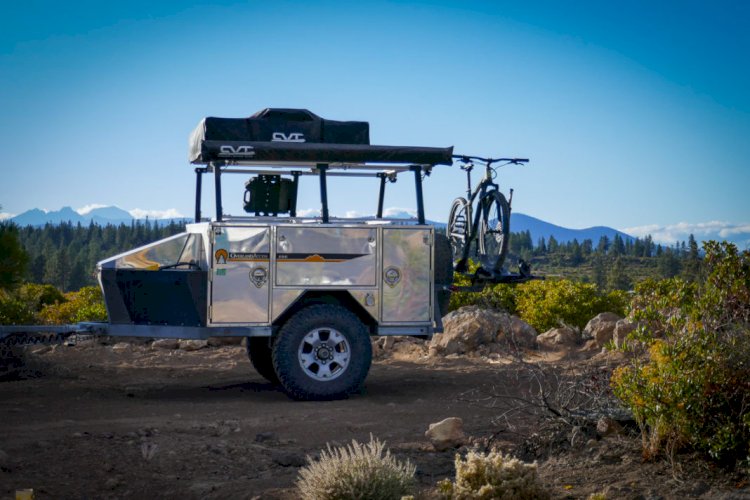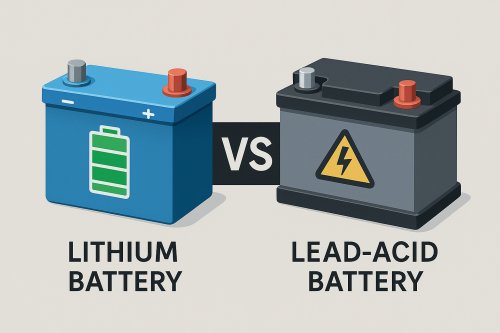Lithium vs Lead-Acid Batteries for Van Conversion: Complete Guide 2025
Complete 2025 guide: Lithium vs lead-acid batteries for van conversion. Compare costs, performance, brands & find the best battery for your build.

Lithium vs Lead-Acid Batteries for Van Conversion: Complete Guide 2025
Choosing the right battery for your converted van is a crucial decision that will directly impact your energy autonomy and travel comfort. The two main technologies dominating the market are lithium batteries (LiFePO4) and lead-acid batteries. Each presents specific advantages and disadvantages depending on your needs and budget.
Lithium Batteries (LiFePO4)
Advantages
Superior energy performance: Lithium batteries offer exceptional energy density, storing up to three times more energy than lead-acid batteries for equivalent weight. This characteristic is particularly valuable in a van where every kilogram counts.
Remarkable longevity: With a lifespan of 10 to 15 years and more than 3000 charge-discharge cycles, lithium batteries represent a long-term investment. They also better maintain their capacity over time, retaining 80% of their performance after thousands of cycles.
Optimized charging efficiency: Energy efficiency reaches 95-98%, meaning almost all stored energy is recoverable. Charging is also faster, allowing 80% capacity recovery in one hour with an appropriate charger.
No maintenance required: Unlike lead-acid batteries, they require no maintenance, no electrolyte level checking, or terminal cleaning.
Deep discharge without damage: You can use up to 95% of their capacity without risking battery damage, maximizing available energy for your equipment.
Voltage stability: Voltage remains stable throughout discharge, ensuring optimal operation of your sensitive electronic devices.
Disadvantages
Higher initial cost: Although the gap is narrowing with the general decrease in lithium prices, the initial investment remains about 2 times higher than lead-acid batteries. However, models with integrated BMS and heating simplify installation by avoiding the purchase of separate components.
Extreme temperature sensitivity: Performance decreases in extreme cold, but new self-heating models largely solve this problem by automatically maintaining optimal temperature.
Specialized installation: Even with integrated BMS, they require specific chargers and minimal understanding of lithium systems for optimal installation.
Lead-Acid Batteries
There are three main types of lead-acid batteries for vans:
Flooded Electrolyte Batteries
- The cheapest ($150-$250 for 200Ah)
- Require regular maintenance
- Emit dangerous gases
- Sensitive to vibrations and tilting
AGM Batteries (Absorbed Glass Mat)
- More expensive than flooded ($250-$400 for 200Ah)
- Maintenance-free
- Vibration resistant
- No dangerous gas emissions
Gel Batteries
- Most expensive of lead-acid ($350-$500 for 200Ah)
- Excellent deep discharge resistance
- Perfect for hot climates
- Slower charging
Lead-Acid Battery Advantages
Financial accessibility: The initial purchase cost is significantly lower, making this technology accessible to limited budgets.
Installation simplicity: Proven technology facilitates installation and maintenance, with many professionals mastering this technology.
Universal availability: Easily found worldwide, facilitating repairs and replacements while traveling.
Temperature tolerance: Function correctly in an extended temperature range, particularly resistant to cold.
System compatibility: Easily integrate with existing charging systems without modification.
Lead-Acid Battery Disadvantages
Weight and bulk: Much heavier and more bulky, they reduce useful storage space and increase fuel consumption.
Limited lifespan: Between 3 and 7 years depending on use, with only 500 to 1200 life cycles, requiring frequent replacements.
Regular maintenance: Open batteries require monthly electrolyte level checking and regular terminal cleaning.
Low energy efficiency: With only 70-80% efficiency, a significant portion of energy is lost as heat.
Discharge limitation: Must not be discharged below 50% of their capacity to avoid irreversible damage, reducing actually usable energy.
Voltage drop: Voltage progressively decreases during discharge, affecting device performance.
Market Evolution and New Options
The lithium battery market for vans has evolved considerably in recent years. Manufacturers now offer "plug-and-play" batteries with integrated BMS and self-heating function for under $1,000. These "all-in-one" models greatly simplify installation and eliminate two of the main historical disadvantages: technical complexity and cold sensitivity.
These new generation batteries generally include:
- Automatic heating system activated below 32°F (0°C)
- Integrated BMS managing cell balancing
- Protection against overcharging and extreme temperatures
- Bluetooth monitoring for remote surveillance
- Plug-and-play connections compatible with existing systems
Recommended brands (prices for 100Ah):
- Battle Born: $900-$1,200 (American manufacturing, 10-year warranty)
- Volthium: $750-$950 (Canadian manufacturing, excellent value, van/RV specialist)
- Renogy: $700-$900 (good value for money)
- LiTime: $600-$800 (excellent budget, decent quality)
- Victron Energy: $1,000-$1,400 (premium, advanced monitoring)
- SOK: $650-$850 (van battery specialist)
For 200Ah, multiply by approximately 1.8-1.9 (economies of scale)
Total Cost of Ownership Calculation
Although the initial lithium investment is higher, the 10-year calculation reveals substantial savings. A 100Ah lithium battery with integrated BMS and self-heating costing between $600-$800 will last 10-15 years, while two equivalent 200Ah lead-acid batteries costing $280 will need replacement 2-3 times over the same period.
10-year cost:
- Lithium 100Ah: $700 (single battery with integrated BMS and heating)
- Lead-acid AGM 200Ah: $840 (3 replacements × $280)
Additional costs to consider:
- Fuel savings (lithium 60% lighter): $200-400/year depending on usage
- Lead-acid maintenance: $50-100/year
- Inverter replacement (lithium extends lifespan): $300 saved
Total 10-year savings with lithium: $800-$1,500
Detailed Technical Comparison
Actual Usable Capacity
| Type | Nominal Capacity | Usable | Lithium Equivalent |
|---|---|---|---|
| Lithium | 100Ah | 95Ah (95%) | 100Ah |
| AGM | 200Ah | 100Ah (50%) | 100Ah |
| Gel | 175Ah | 122Ah (70%) | 100Ah |
| Flooded | 225Ah | 112Ah (50%) | 100Ah |
Temperature Performance
Lithium:
- 32°F to 104°F (0°C to 40°C): Optimal performance
- Below 32°F: Automatic heating (recent models)
- Above 104°F: Progressive performance reduction
Lead-Acid:
- 14°F to 122°F (-10°C to 50°C): Acceptable operation
- 50% performance reduction at 14°F (-10°C)
- Lifespan halved above 95°F (35°C)
Charging Time
Lithium:
- 0-80%: 1-2 hours
- 80-100%: 2-3 additional hours
- Accepts high charging currents
Lead-Acid:
- 0-80%: 4-6 hours
- 80-100%: 6-8 additional hours
- Slow charging necessary for longevity
System Sizing
Energy Needs Calculation
Average converted van consumption:
- LED lighting: 20-40Ah/day
- 12V refrigerator: 60-120Ah/day
- Electronic chargers: 10-30Ah/day
- Water pump: 5-15Ah/day
- Ventilation: 20-60Ah/day
Average total: 115-265Ah/day
Recommended Autonomy
Occasional use (weekends):
- 1-2 days autonomy
- Lithium 100Ah or AGM 200Ah
Regular use (1 week/month):
- 2-3 days autonomy
- Lithium 200Ah (2×100Ah) or AGM 400Ah
Nomadism (permanent use):
- 3-5 days autonomy
- Lithium 300-400Ah (3-4×100Ah) minimum
- Robust charging system essential
Charging Systems
Solar Panels
Lithium: Accept fast charging, easy optimization
- 200W minimum for 100Ah
- 400W minimum for 200Ah (2×100Ah)
- MPPT controller mandatory
- Excellent efficiency even in low light
Lead-Acid: Slower charging, oversizing necessary
- 300W minimum for equivalent 100Ah usable
- 600W minimum for equivalent 200Ah usable
- PWM controller acceptable but MPPT recommended
Vehicle Alternator
Lithium: DC-DC charger mandatory
- Additional cost: $200-$400
- Fast and efficient charging
- Alternator protection
Lead-Acid: Direct connection possible
- Battery isolator: $50-$100
- Slow but functional charging
120V Mains
Lithium: Specialized charger
- Cost: $300-$600
- Fast and intelligent charging
Lead-Acid: Standard charger
- Cost: $100-$200
- Slow but sufficient charging
Recommendations by Usage
Choose Lithium If:
- You travel frequently (more than 30 days/year)
- Energy autonomy is priority
- You have demanding electronic equipment
- Van weight is a constraint
- You prioritize peace of mind (no maintenance)
- Your budget allows initial investment
- You travel in cold climates (with heating models)
Choose Lead-Acid If:
- Occasional use (less than 15 days/year)
- Very tight initial budget (less than $500)
- Preference for simple and proven technology
- Easy travel repair priority
- Very low energy consumption
- Van used mainly in temperate climates
Installation and Safety
Lithium Installation
New lithium batteries with integrated BMS have considerably simplified installation. Many connect directly like a traditional lead-acid battery, while offering advanced features via Bluetooth for monitoring.
Essential elements:
- Appropriate fuse or breaker (100-150A for 100Ah, 200-300A for 200Ah)
- Proper cable section (4 AWG minimum for 100Ah)
- DC-DC charger for alternator
- System monitoring (often integrated Bluetooth)
Complete installation cost: $300-$600
Lead-Acid Installation
Necessary elements:
- Adequate ventilation (mandatory for flooded)
- Solid anti-vibration mounting
- Battery isolator or relay
- Voltage monitoring (voltmeter)
Installation cost: $150-$300
Safety
Lithium:
- No dangerous gases
- Fire risk in case of BMS failure (very rare)
- Short-circuit protection crucial
Lead-Acid:
- Explosive gases (hydrogen) - ventilation mandatory
- Corrosive acid - protection and regular cleaning
- Explosion risk in case of overcharging
Maintenance and Monitoring
Lithium
Maintenance: None Recommended monitoring:
- Smartphone app (Bluetooth)
- Cell voltage monitoring
- System temperature
- Charge/discharge history
Lead-Acid
Monthly maintenance:
- Electrolyte level checking (flooded)
- Terminal and connection cleaning
- Rest voltage control
- Mounting verification
Monitoring:
- Digital voltmeter
- Battery monitor with shunt (recommended)
Environmental Impact
Lithium
- 3-4 times longer lifespan
- Recycling possible but emerging sector
- Significant lithium extraction impact
- Favorable carbon footprint over lifespan
Lead-Acid
- Mature recycling (95% of batteries recycled)
- Frequent replacements increase impact
- Less impactful unit production
- More polluting transport (high weight)
Future Evolution and Trends
The market is rapidly evolving toward lithium with prices continuing to fall. Recent innovations include:
Emerging technologies:
- LiFePO4 batteries with 6000+ cycles
- Extensible modular systems
- IoT integration for advanced monitoring
- Wireless induction charging
2025-2030 predictions:
- Lithium prices: 20-30% decrease
- Energy density: 15-25% improvement
- Democratization of premium functions
- Progressive disappearance of flooded batteries
Conclusion and General Recommendation
With current prices and new integrated technologies, lithium batteries become the optimal choice for the majority of modern van installations. The initial investment, while higher, is largely compensated by long-term savings, superior performance, and peace of mind.
Our 2025 recommendation:
For 90% of converted van users, one or two 100Ah lithium batteries with integrated BMS and self-heating function represent the best choice. The price gap has narrowed sufficiently to justify the investment, even for moderate budgets. Starting with 100Ah also allows a modular approach - adding a second battery according to actual needs.
Lead-acid batteries remain relevant only for:
- Very small budgets (less than $500 total)
- Very occasional use (less than 10 days/year)
- Situations requiring emergency travel repair
The future clearly belongs to lithium in the converted van world, and 2025 probably marks the year of definitive transition for the majority of new conversions.
Share
What's Your Reaction?
 Like
1
Like
1
 Dislike
0
Dislike
0
 Love
0
Love
0
 Funny
0
Funny
0
 Angry
0
Angry
0
 Sad
0
Sad
0
 Wow
0
Wow
0












